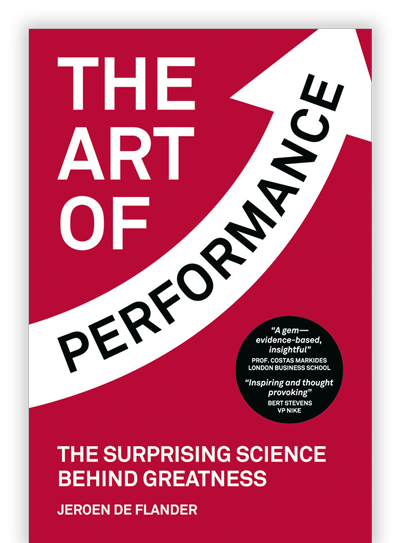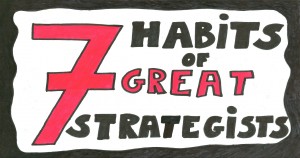Strategy Execution - The definitive guide - Jeroen De Flander
Strategy execution: this is the ONLY tutorial you'll need to boost your business strategy & strategy implementation skills!
Strategy Execution – The Definitive Guide To Boost your Strategy Implementation Skills

Successful strategy execution (strategy implementation) is crucial in strategic management! According to Harvard Business Review, “Companies realize only 40-to-60 percent of their business strategies’ potential value”. Successful leaders know these numbers and understand it takes much more than a great business strategy to be number one. You need to turn that great strategy into great performance.
That’s where strategy execution comes in. It bridges the gap between brilliant strategies and superior performance. Led by Balanced Scorecard icons Kaplan and Norton and best-selling authors Bossidy and Charan, Strategy Execution has become a fast-growing bleep on the radar screens of top executives. But simply appearing on that radar is not enough to make it happen. Each company, large or small, needs to master crucial Strategy Execution skills. And that’s where this guide can help. It covers all the important strategy implementation building blocks [model, process, framework, definition, examples, PPT, ….] using video’s, tips, ebooks and much more!
Check out the table of contents below for some quick jumping around.
Updates to this Strategy Execution article
This article has been kept up to date with the best strategy execution practices since December 2012. The most recent update was on March 2nd, 2024.
NEW! Check out the free online strategy execution university
The goal of this strategy implementation guide is to let all the info of all the different blog posts, articles and ebooks I wrote about strategy execution, here and on other sites, fall into one big piece: the ultimate strategy execution training manual!
1. Successful Strategy Execution needs a sound Business Strategy
Successful strategy execution is driven by a solid business strategy. No matter how well you execute, if you set off in the wrong direction, all strategy implementation efforts are just a waste of time. Think about the saying ‘rubbish in, rubbish out’. A strategy execution hero needs to know what a solid business strategy is made of. And should be able to spot a poor one and challenge it properly.
This is my most popular guide: 7 things every leader should know about strategy
It answers the question: “What is strategy?” in a no nonsens way.
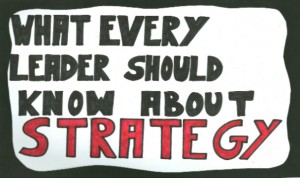
1.2. 7 Habits of great strategists
A great business strategy is developed by a team, a strategist leading the way.
I’ve come across many strategists in my career. Some were bad. Most were average. Only a few were truly incredible. The things that great strategists do on a day-to-day basis may not show up on the average radar. But for those who look carefully, they become visible.
Here’s a cool article with a list of what great strategists frequently do.
1.3. 8 strategy questions every CEO should ask
It’s one thing to know what strategy is all about, but it’s another to get out there and come up with one.
As you will probably agree, there is no magic formula for crafting the perfect business strategy. If there was, the business world would look a lot different. But that does not mean there aren’t a few shortcuts that you can take. Let’s take a closer look at how you can develop a sustainable competitive advantage: 8 strategy questions to inspire your strategic thinking.
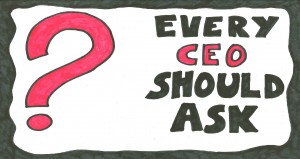
Shared value is new business strategy concept developed by Porter and Kramer. It explains how we can use shared value to create a sustainable competitive advantage.
1.4. Inspiring strategy quotes

When communicating about business strategy, you might want to insert some strategy quotes into your presentation. Here are some of my favorite strategy quotes:
“Strategy is a pattern in a stream of decisions”
—Henry Mintzberg
“The essence of strategy is choosing what not to do.”
—Michael Porter
“We don’t like their sound, and guitar music is on the way out”
—Decca Recording Co. rejecting the Beatles 1962
“Perception is strong and sight weak. In strategy it is important to see distant things as if they were close and to take a distanced view of close things”
—Miyamoto Musashi, legendary Japanese swordsman
Want more? Here’s my ultimate strategy and strategy execution quotes list.
2. Strategy Execution definition
There are quite a few different strategy execution definitions. When I define strategy execution, I like to start from a famous Mintzberg quote.

A long time ago, I learned this phrase by heart—but it took me 5 years to really grasp the point of it.
The trick I use to understand Mintzberg’s cryptic statement is to approach decisions in 2 steps.
First, there’s the overall decision—the big choice—that guides all other decisions. To make a big choice, we need to decide who we focus on—our target client segment—and we need to decide how we offer unique value to the customers in our chosen segment. That’s basic business strategy stuff.
But by formulating it this way, it helps us to better understand the second part, the day-to-day decisions—the small choices—that get us closer to the finish line. When these small choices are in line with the big choice, you get a Mintzberg Pattern.
So if strategy is a decision pattern, strategy execution is enabling people to create a decision pattern.
In other words:
“Strategy execution is helping people make small choices in line with a big choice.”
That’s my strategy execution definition.
But this notion requires a big shift in the way we think about execution.
As a strategist looking at strategy execution, we should imagine a decision tree rather than an action plan!
Decisions patterns are at the core of successful strategy journeys, not to-do lists!!
To improve the strategy implementation quality, we should shift our energy from asking people to make action plans to helping them make better decisions.

Execution synonym
1. When we talk about strategy implementation vs strategy execution, we talk about the same thing. In other words, an execution synonym is ‘implementation’. You can change the word ‘execution’ everywhere in this guide by the word ‘implementation’ and you still have the same meaning.
2. When we talk about strategy vs tactics there is a huge difference. Strategy is ‘the choice’, tactics are the operational side of this choice. I consider tactics as part of strategy execution but do not consider it an execution synonym as it mainly focuses on the planning side of doing things, like a ‘tactical’ meeting.
“What is strategy execution?”
Let’s take a closer look at what strategy implementation is all about:
1. Strategy Execution bridges the gap between a great business strategy and great performance.
2. Strategy Execution is a vast area with blurred borders. It includes several processes – from budgeting to evaluating individual goals. And involves all functional domains.
3. Strategy Implementation is a discipline of its own. Making business strategy work isn’t the same as strategy making. It’s a different game with its own rules, potential pitfalls and best practices
4. Strategy Execution involves everyone. From the CEO to the blue-collar worker, everyone is involved in executing the business strategy. Their roles might be different, but all individuals contribute to the organization’s execution effort.
5. Strategy Implementation takes time. You can build a business strategy in a few weeks (or months at the most) but the strategy implementation takes several years. It’s a sprint versus a marathon.
6. Strategy Execution demands short- AND long-term thinking. While executing, you need to manage your long-term implementation plan and worry about the nitty-gritty actions you will take tomorrow.
7. Strategy Execution demands a specific set of behaviors and techniques that companies need to master in order to have competitive advantage. It’s a discipline of its own. (Charan & Bossidy, Execution)
8. Great Strategy Execution requires a great business strategy. It cannot exist without it. Great strategy implementation can never compensate for a poor business strategy.
9. Strategy Implementation isn’t something you worry about after you have already finished crafting your business strategy. You need to think about the strategy implementation challenges at the same time you design your strategy.
10. Strategy Execution has a strong timing sequence. You don’t do everything at the same time. One thing happens before the other, and the order is important.
11. Strategy Implementation requests a seamless integration between organizational and individual performance. You can look at performance from either an organizational or an individual perspective. But in order to realize your business strategy, a connection between both is crucial.
12. Strategy Implementation creates a big performance gap in most organizations. According to Harvard Business Review, companies lose between 40-to-60 percent of their strategic potential during the execution phase.
13. In many organizations, Strategy Execution is still a black box. You throw your business strategy in one end and performance comes out the other end.
14. Strategy Execution asks for measurement. Organizations need to start by understanding in more detail where the Strategy Execution process leaks performance. A benchmark can help tremendously.
15. It takes time to build Strategy Execution capabilities. Small organizations should count on 18 months to become best-in-class. For a large multinational, it can take up to three years to get there. Your measurement approach should take the long-term into account.
16. Strategy Execution has grown out of its infancy and is on its way to maturity.
17. A simple Strategy Execution process like the 8 Model orients managers to take the right actions at the right time.
18. Strategy Implementation offers new chances for creating competitive advantage. Make sure you are the first in line to fully exploit the opportunity.
19. Strategy implementation is part of a leaders’s role. In fact, it’s a crucial building block – a leadership essential.
20. Unfortunately, and for many reasons, some managers – the strategy tourists – see strategy execution as something others should do while they are working on something ‘more important’.
21. Strategy Execution needs heroes, leaders who take on the implementation challenges and get things done.
Strategy Execution Facts and Figures
More and more people are convinced about the importance of strategy execution. But there’s still a small group that needs a nudge, a small push in the right direction. Here are 20 strategy implementation facts and figures that help you get this done.
1. Companies realize only 63% of the financial performance their strategies promise because of defects and breakdowns in strategic planning & execution. More than 1/3 placed the figure at less than 50%. (Harvard Business Review)
2. 15 percent believe the business strategy to be wrong for their company. (the performance factory)
3. Almost all – 94 percent – have KPI’s that relate not only to financials, but also to customers, processes or people. (the performance factory)
4. Around 1 in 3 – 30 percent – receive no information on how to execute the business strategy. (the performance factory)
5. Only 61 percent is convinced that the strategic projects are staffed with the right people. (the performance factory)
6. As little as 27 percent believe that the strategic projects are being managed correctly. (the performance factory)
7. 27 percent doesn’t receive any individual feedback. (the performance factory)
8. As many as 17 percent lack leadership goals. (the performance factory)
9. 17 percent indicate that performance isn’t monitored. (the performance factory)
10. Only 7% of employees today fully understand their company’s business strategies and what’s expected of them in order to help achieve the company goals. (SuccessFactors)
11. 38 percent indicate that poor performers don’t face any consequences. (the performance factory)
12. More than one third – 37 percent – have never had the opportunity to participate in a 360° skills assessment exercise. (the performance factory)
13. 18 percent is unable to explain how to set individual goals. (the performance factory)
14. The implementation of a performance management system based on the Balanced Scorecard leads to immediate, noticeable improvement of the financial results and a better understanding of the operating model. Only 5% of the companies studied haven’t noticed any improvements. (Manager & Literatuur)
15. 27 percent receives no training on essential management skills. (the performance factory)
16. 36 percent do not question appraisals objectively. (the performance factory)
17. Of all managers, 24 percent do not receive any useful business strategy information from other departments. (the performance factory)
18. Only about 20% of workers say their managers coach them regularly to help them improve their performance. (HRI)
19. Companies rarely track performance against long-term plans: less than 15% of companies make it a regular practice to go back and compare the business’s results with the performance forecast for each unit in its prior years’ strategic plans. (Harvard Business Review)
20. For a typical business unit, top management and the board should monitor no more than 3 to 5 metrics, representing different areas of the business for each of the three time frames: short-term, over the next 1-5 years, and long-term. (Mc Kinsey Quarterly)
And finally, think about this one next time you take a decision: best-selling author Paul C. Nutt did extensive research on decision making for his book Why Decisions Fail. He found that more than 50 percent of all decisions fail. They are either quickly abandoned, partially implemented or never adopted at all. 81 percent of all managers pushed their decisions through persuasion and edict. And only 7 percent were based on long-term priorities.
Despite these shocking figures, 91 percent of the managers in Nutt’s study rated themselves as exceptional decision-makers 🙂
Strategy Implementation Challenges
This strategy execution ebook covers six crucial strategy implementation challenges and offers practical tips on how to overcome them.
3. Strategy Execution framework: the 8
3.1. The 8, a simple Strategy Execution model
Strategy Execution is a complex process. In fact, it’s a mix of several processes. And the ideal process picture is different for each organization.
But even with a different mix, each best-in-class strategy implementation process should include some basic building blocks. Luckily, many of them are readily available within most organizations.
They include:
- Tried and tested approaches for reviewing a business strategy.
- Strategy cascade tools, the Balanced Scorecard being the best-known.
- Techniques to structure, execute and monitor strategic projects.
- A proven approach to set, monitor and evaluate personal goals.
What is lacking however, is a simple framework to integrate and align all of these different building blocks. And that’s where the 8 Model comes in. It combines the most important strategy execution steps into a coherent process.
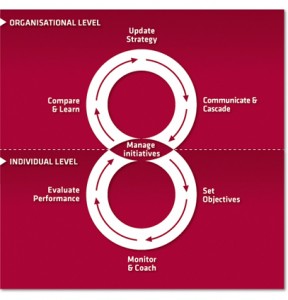
The 8 Model doesn’t cover all of the ins and outs of the Strategy Execution process. It’s not supposed to. It’s not a rigid step-by-step instruction. But it does provide a necessary, simple strategy execution framework.
You can make your strategy execution framework more complex if you prefer. For the organizational cycle in particular, there are some sophisticated models around. Kaplan and Norton describe one in their latest book The Execution Premium. You can find a second one that also includes organizational structure impacts in Making Strategy Work by Hrebiniak.
While I like the insights that this strategy execution framework from Kaplan & Norton or Hrebiniak provides, their complexity makes them unsuitable as a day-to-day Strategy Execution framework for the whole organization. I believe a strategy implementation model needs to be simple, highly recognizable and a bit sexy 🙂 (Think like a marketer and make it stick).
I’m aware that you will lose some of the nuances, but that’s a choice you need to make. Besides, it doesn’t mean you have to over-simplify your Strategy Execution framework. You can use the 8 for communication purposes and keep a more detailed version to be known only by those who have to organize the process.
Not convinced yet?
Here are two ‘content’ arguments:
- The 8 shows the importance of aligning individual and organizational performance, one of the most important things you can do to improve your success rate.
- The 8 gives initiative management the attention it deserves (read ‘needs’). International research from the performance factory shows that initiative management is the single most important execution problem that companies face. In other words, it’s the place where most performance is lost.
So, if you look for a simple, highly recognizable Strategy Execution framework that emphasizes the link between individual and organizational performance and gives initiative management the importance it deserves, go for a simple strategy execution model, the 8.
3.2. The strategy execution model building blocks
Here’s a short video about the strategy execution framework:
Here’s an overview of the strategy implementation model:
1. Update Strategy
Your business strategy is your long-term, big choice. Each strategy is unique, and it should also be measurable and easy to understand. Depending on the industry you are in, it maps the road your company should take for the next 3 to 10 years. On a regular basis − most companies should do this annually – a company needs (and wants) to update its strategy based on changes in its competitive environment and on the strategy execution feedback from the previous cycle. We include strategy updates in our execution framework as they take place on a regular, recurring basis at all levels of the organization. The real strategy work, conducted only once every 3 to 5 years at the top of an organization, is excluded.
2. Communicate
As soon as your strategy (or strategy update) is finalized and approved by all stakeholders, you should focus on strategy communication. Transparent and easy-to-understand communication creates the necessary understanding and engagement for the new/adapted strategy. It is essential to use all available communication platforms. One big strategy event and a single strategy e-mail are not nearly enough. Use other meeting platforms, discussion groups, informal and formal encounters, performance management sessions, intranets, websites, screen savers, coffee corners, billboards, etc. to communicate the strategy.
Pay attention to the quality of your strategy communication. Senior managers, in particular − as strategy ambassadors − should be especially careful about how they communicate. In addition to the content itself, tone of voice and presentation skills are essential elements in transferring content and creating the necessary enthusiasm for others to pass on the message. Make sure you don’t kill your strategy by lousy, uninspiring communication.
3. Cascade
When you cascade your business strategy, you break down objectives into smaller chunks for the next organisational level. The process stops at the smallest unit level − these are often teams. In the end, the size of your organisation will define the size of the cascade. It is crucial to achieve macro alignment between all the objectives – horizontally and vertically – in your organisation. We call this MECE. Take a look at the first Strategy Execution law in our free library for more information. On a micro level, you need to balance your objectives across perspectives. The 4 traditional perspectives are: financial, customer, internal processes, and people. You can add other dimensions, as appropriate. In addition to the balancing act on the macro and micro levels, you need to select the right indicators – often called Key Performance Indicators or KPI’s − to track the objectives and define appropriate targets.
4. Compare & Learn (KPI’s)
Your business strategy is a hypothesis. It’s your best estimate of the route to success … but it’s still an estimation.
It’s crucial to take some time at the end of a cycle to go back and check your hypothesis. To check your strategy against reality. To do this, you need solid Key Performance Indicators or KPI’s.
5. Manage initiatives (projects)
Initiative management is the activity in which your dreams run up against reality, your business strategy meets operations, and resources are added to the strategy formula. This is one of the most difficult steps in Strategy Implementation − and so it’s also where execution quite often goes wrong.
Initiative management is about selecting, prioritizing and executing the right projects.
6. Set Objectives (smart goals)
Smart goal setting is one of the best things you can do to improve performance. Your own performance (personal goals) and (if you have them) your team members’ performance. The positive impact of goal-setting is one of the most widely researched and scientifically validated aspects of today’s organisational science. Two key researchers of goal-setting theory are: Edwin A. Locke (University of Maryland) and Gary P. Latham (University of Toronto).
Make sure you link all individual objectives with the strategy at the organisational level. If you don’t, you might have a great objective … but it’s of no use to the organisation!
Also, make sure you focus on the way you secure agreement on the goals. It’s the quality of the objectives – including the link with the overall company objectives – AND the acceptance of the objectives that will make your individual objective-setting a success.
Want to know more about goal setting? Check out this mini guide about personal goals.
7. Monitor & Coach
Regular coaching motivates people and increases their chances of success dramatically. It also simplifies the final performance evaluation. In fact, regular performance coaching is far more important than the formal review meeting somewhere around the middle of the year.
Providing feedback in the right way − which is a key coaching skill − is a crucial step in boosting performance!
Performance coaching is a relatively new, but rapidly growing, knowledge field. The leading authority is Sir John Whitmore.
8. Evaluate Performance
Most organizations conduct a formal performance evaluation at the end of the individual performance management cycle. Ideally, the evaluation should answer the question: have the individual performance goals been achieved?
Be sure you make an honest assessment. There are several techniques that can help you. One of the best known is the STAR technique. Although many organizations link performance to remuneration, performance evaluation is − and should be − a separate process.
Read more: Here is an advanced guide with 27 practical tips to boost your strategy implementation process.
Strategy execution PDF
Now, more than ever, we need a different way of thinking, a useful way to focus and turn our business strategy into success.
I hope this ebook It’s All About Strategy Execution will get you started on that path. In the book, six senior executives from different fields and industries share their vision of Strategy Implementation.
You will find tried and tested insights from:
- Michael Smith, VP Group Strategy and Planning North America, Coca-Cola
- Shane Dempsey, VP HR and Communications Europe, Novo Nordisk
- Douglas Johnson-Poensgen, VP Business Development, BT
- Alan Maxwell, VP Human Resources,Lockheed Martin
- Jean-Francois Van Kerckhove, VP Corporate Strategy, eBay
- Hervé Borensztejn, SVP Human Resources, EADS.
4. Strategy Communication
Reach for the head, heart and hands
The communication of business strategy and its execution comes in different shapes and forms: from individual conversations during objective setting over group interactions around the Balanced Scorecard, and from intranet postings to writing a memo regarding a strategy shift. But they all serve one purpose: to get the strategy into the heads, hearts and hands of the people.
Heads, hearts and hands
- Heads: You want everyone to understand the business strategy.
- Hearts: You want everyone to be motivated by the business strategy.
- Hands: You want everyone to take action to get things done.
Strategy communication is crucial to strategy implementation success. Communication of the business strategy and its execution is an essential, ongoing component of your strategy implementation efforts. And although some elements might seem trivial and simplistic on the surface as everyone can communicate to some degree, the reality shows that it demands substantial skill and knowledge to communicate the relevant information to the desired person that results in the required action.
So the question isn’t so much if you communicated but how well.
In other words, don’t focus on the question ‘Was my message communicated?’ but rather on ‘Was my message effective?’.
Look beyond the send button and shift your focus to the receiving end.
Why do people talk about your business strategy?
I will talk about the corporate business strategy…
…because I feel smart showing others what I know.
…because I care about the outcome and want the company to succeed.
…because I have no choice. Everybody else is talking about it.
…because there’s a financial benefit directly to me – my bonus is linked to the realization of the strategy.
…because I get bombarded with information.
…because I believe we have a cool strategy.
…because I don’t agree and want to share alternative options.
…because my employees ask me to.
…because it’s expected of me – I’m the boss.
…because I want to link our team objectives to the overall strategy.
…because I’m convinced everyone needs to know – strategy communication is key.
…because I’m a strategy tourist and I like talking about strategic stuff – it makes me feel important.
But talking should not be overrated…
It’s what we do that matters.
But if we are honest, we all talk too much and do too little.
… we say that the new company strategy is the best we had in years but, deep down, we don’t really understand it.
… we say a good leader needs to act transparent, but that last little project hick-up is best covered up. It might cost us our next promotion. And, it’s very likely that nobody will notice anyway.
… we say people development is crucial, but we don’t need it ourselves and the people in our team are too busy running the business.
… we say that simplicity is crucial, but have just implemented two new software tools.
… we say communication is key, but always postpone it until the next phase is ready.
… we say strategy execution is important, but we don’t teach our people how to do it.
… we say we love innovation and dwell about the success of Apple, but we have not produced a single new idea in the last 12 months and shot at least 20 from our peers.
The problem isn’t in what we say. It’s what we do.
A great strategy story needs:
… a compelling business case that creates enthusiasm and inspires people.
… a simple story line so it’s easy for employees to pick it up and repeat the story vividly at the kitchen table.
… consistency. Stick to the message and make sure others do too.
… to be easy to relate to. People need to see how they fit in.
… great communication skills to get the strategy into the heads, hands and harts of the employees.
… a heavy investment in awareness creation.
… role models.
5. Strategy Execution Cascade
Once you have defined your business strategy, it’s time to cascade it across the organization. The Balanced Scorecard is the best-known technique to do so.
Here are some Balanced Scorecard facts and figures:
5.1. Facts and figures about the Balanced Scorecard
Who invented the Balanced Scorecard?
Contrary to popular belief, the first Balanced Scorecard was not created by Dr Robert S. Kaplan and Dr David P. Norton, but by Art Schneiderman – a fact that I was unaware of until a few years ago. At the time of its conception, Schneiderman worked as an independent consultant for Analog Devices, a mid-sized semi-conductor company.
Here’s the story. In 1990, Schneiderman took part in a research study by Robert Kaplan of the Harvard Business School and US management consultancy Nolan-Norton. Subsequently, Kaplan and Norton included anonymous details of this use of the Balanced Scorecard in their 1992 article on the Balanced Scorecard. Their article Measures That Drive Performance published in the Harvard Business Review (1992) wasn’t the only paper published on the topic that year, but it was a great success and received much attention. In 1996, they published the bestselling The Balanced Scorecard, Translating Strategy into Action.
The initial high-profile articles and this highly successful book have made the BSC well-known, but perhaps also wrongly led to Kaplan and Norton being seen as the creators of the Balanced Scorecard concept.
So if you are a Scorecard fan, give credit to Robert Kaplan and David Norton, the founding fathers of modern strategy implementation thinking, for making it common knowledge. But thank Art Schneiderman for conceptualizing the Balanced Scorecard itself.
Foundations of the Balanced Scorecard
While the term and the concept of the Balanced Scorecard was invented by Art Schneiderman and made famous by Kaplan and Norton, the roots of performance management as an activity go further back in time. Management historian Alfred Chandler points out that early performance management practices go right back to the early 19th century and the emergence of complex organizations.
Did you know that the Balanced Scorecard is the sixth most used management instrument in organizations today?
It’s an essential management system and a cornerstone of successful Strategy Execution
What does a Balanced Scorecard actually do?
The Scorecard provides a framework for translating an abstract strategy into specific, concrete objectives, measures, indicators and actions. It combines a ‘balanced’ (cause/effect) view with a ‘scoring’ (measuring/tracking) view. It focuses on aligning the goals of business units, teams and individual employees with the company’s overall business strategy. A great Balanced Scorecard breaks a business strategy down into specific and measurable chunks. It also keeps the long-term strategic goals visible on the radar.
The ultimate goal of a Balanced Scorecard is to experience Strategy Execution as a continuous process. Today, the Balanced Scorecard provides much more than multi-view measurement; in many organisations, it’s an essential management system and a cornerstone of successful Strategy Execution.By helping organisations detect problem areas and ensuring that managers and employees focus their energies in the right areas, the Balanced Scorecard also becomes an important foundation for operational management.
The Balanced Scorecard should not be viewed as a controlling instrument. Its ultimate goal is to create focus for what’s really important for the future, ensuring that all employees contribute to the realization of the company’s mission and strategic goals. Measurement is a means to reaching a goal and not a goal in itself.
The Scorecard is also about learning and teaching; about your strategy, the assumptions you have made regarding winning in the marketplace and the value proposition you have put forward. It can be a crucial lever to communicating your business strategy.
5.3. The 4 benefits of a Balanced Scorecard
The next two sections are a summary from the Balanced Scorecard guide.
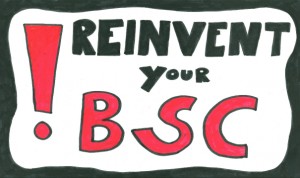
1. The Balanced Scorecard cascades your strategy
2. The Balanced Scorecard measures your strategy progress
3. The Balanced Scorecard communicates your strategy
4. The Balanced Scorecard boosts your strategic thinking skills
5.4. 14 tips to get the most out of your Balanced Scorecard
Check out the ultimate guide about the Balanced Scorecard and some KPI guidelines.
6. Individual Goal Setting
Goal setting is one of the keys to Strategy Execution success. It’s the final step in your strategy cascade. And it fuels the motivation of the individuals who adopt small pieces of your corporate strategy and transform them into desired performance.
Successfully achieved, goal setting is a real strategy implementation booster.
id you know that the goal-setting theory is one of the most scientifically valid and useful theories in organisational science? The positive results of setting goals within the world of work are widely supported by substantial research – more than 100 scientific studies involving 40,000 participants from different industries. And these figures don’t even include any goal-setting research that took place in the world of sport.
The research revealed some fascinating results. Here’s a guide covering the 12 essential elements from the goal setting theory and 6 tips to improve your goal setting process in the workplace.
And also a detailed guide about an easy-to-use goal setting template.
7. Performance Coaching
Strategy Execution is made up of many, MANY individual execution efforts – an infinite list of small decisions taken up by different people at different times. Performance coaching helps this decision process by creating the necessary commitment with the individuals involved to move these actions forwards. In other words, business coaching creates engagement to get things done.
There are dozens of coaching methods out there, some better than others. The good ones will help you as a coach to facilitate learning rather than to direct it.
GROW – originally conceived by Graham Alexander and further perfected by John – is probably the best-known and appreciated coaching technique in the world.
- G for Goal setting: define the short- and long-term goals
- R for Reality: explore the current situation
- O for Options: identify and evaluate different action strategies
- W for Will: what will you do by when?
Unlike other techniques, it is much more than a toolbox linked to an acronym. It’s an approach, a philosophy which helps you create the right context to help individuals transform their potential into peak performance. And I believe that’s exactly the reason for its success.
I have written two long guides about coaching (1) the GROW Coaching Model, covering the definition, tips and 56 example questions you can use to boost your coaching efforts and (2) Performance Coaching, including 30 tips from Sir John Whitmore.
8. Strategy Execution Quotes

Here are my favorite strategy execution quotes to spice up your next presentation:
“However beautiful the strategy, you should occasionally look at the results”
– Sir Winston Churchill
“Execution is a specific set of behaviors and techniques that companies need to master in order to have competitive advantage. It’s a discipline of its own”
—Ram Charan and Larry Bossidy, Execution
“Strategy Execution is the responsibility that makes or breaks executives”
—Alan Branche and Sam Bodley-Scott, Implementation
“Persistence is what makes the impossible possible, the possible likely, and the likely definite”
—Robert Half
“There is nothing so useless as doing efficiently that which should not be done at all”
—Peter Drucker
“Building a visionary company requires one percent vision and 99 percent alignment”
—Jim Collins and Jerry Porras, Built to Last
“The best time to make up your mind about people is never”
—Katharine Hepburn in The Philadelphia Story
“Any intelligent fool can make things bigger and more complex. It takes a touch of genius – and a lot of courage – to move in the opposite direction”
—Albert Einstein
“The ability to simplify means to eliminate the unnecessary so that the necessary may speak”
—Hans Hoffmann, Introduction to the Bootstrap
“Simplicity is the ultimate sophistication”
—Leonardo Da Vinci
“You can have anything you want – you just can’t have everything you want”
—Anonymous
“Plans are only good intentions unless they immediately degenerate into hard work”
—Peter Drucker
“Initiative prioritization doesn’t mean distributing all available resources to all known projects”
—Volker Voigt
“An organization’s ability to learn, and translate that learning into action rapidly, is the ultimate competitive advantage”
—Jack Welch
- Related links
- Here’s my ultimate strategy and strategy execution quotes list.
- Famous success quotes [with cool video]
- Quotes about Leadership
Strategy and strategy execution trends
Here are some trends to watch:
Shared Value: a new approach to capitalism

Sustainability is a trend that was identified some years ago and is seeing continuous growth.
But the notion of Shared Value is quite new, a business strategy approach where a company looks at strengthening its strategic position and advances society at the same time. It was introduced by Porter and Cremer and is a concept that’s gaining more and more followers. The concept of Shared Value builds on the notion of Corporate Social Responsibility, but moves away from the traditional trade-off thinking that if you do good for society, you hurt business and vice versa.
Sustainability is more than the latest hype and will become an increasingly important topic. I predict that the notion of Shared Value will also become more important as sustainability becomes a strategic differentiator and those companies that find ways to create shared value will have a better competitive position.
Read more: The Ultimate Shared Value Guide
From time management to energy management
When time management became popular, it seemed to be a solution to all business problems. Everyone took time management courses and started looking for efficiency gains everywhere. Companies promoted it and started carefully monitoring the use of time.
But since time management became popular, the world has dramatically changed, our business interactions speeding up tremendously. Thirty years ago, a typical business interaction went something like this. Your company wants to do business with another company. After a nice lunch to talk about opportunities, you send a letter to the contact person to formalise ideas. A few days later, the recipient plans an internal meeting to discuss the matter, the results are dictated to a secretary who sends a letter back.
You plan a meeting in two weeks to discuss it further…” Today, you might talk to your boss after lunch, then write an email that evening to your contact person. You receive a response by midnight saying she will discuss your feedback with her boss. At lunchtime the next day you get a formal email confirming the agreement.
It is a mistake to think that the increased speed of business is only technology driven. Yes, it’s true that new means of communication enable us to communicate faster, but the real change is in the mindset. We expect things to move forwards at the same speed as technology. If we don’t get a response to our email within the next 12 hours, we believe something is wrong.
And as today’s technology is so advanced, we – the managers – have become the bottleneck. We have reached the time management optimum as there are only 24 hours in a day and only so many emails we can write and respond to in an evening.
What’s the result?
We try to become even better at time management and start to cut corners. A typical example is collective smart phone sessions. It is still called a meeting, but in reality it’s just a bunch of individuals sitting around the same table cleaning out there inbox while somebody in front makes some background noise. But if we are honest, that’s not the solution either.
The biggest problem is that people don’t cope with work anymore, the speed and the feeling that work is never-ending is stressful. There have never been so many people suffering from burnout in the Western world. In fact, a number of organisations that we talked to list avoiding burnout in the top three of their HR priority list.
So what’s the solution?
We have to evolve our thinking from time management to energy management. The limits of productivity are not defined by time or hours of work, but by the energy levels we have.
We believe it’s crucial to have such a debate in every organisation and look for paths to better energy management. There is an organisational angle where the cultural elements have a big impact, for example, do you have a culture of endless meetings in your company and on a personal level, do you know when you go into overdrive and it’s time to take a break?
The speed of technology will not decrease so energy management will become more and more important on an organisational and individual level. We will have to learn how to manage the overall energy balance of the organisation as well as personally managing our own energy levels. To do this, we have much to learn from the younger generation who cope much better with the new time dilemma. They understand it’s impossible to follow the speed of technology and they clearly say no to certain things. They make choices.
And finally, a comment on energy management in times of crisis. For most individuals, a crisis is a stressful period in their business life. And quite a few of them are stretched to the limit, with the risk of burnout just around the corner. When the economy picks up, companies shift gear again, demanding that people go the extra mile. There is a risk that this could prove a push too far. Be aware of the impact that the crisis has had and continues to have on the energy levels of people in your organisation and take action to restore the balance before jumping into a new venture.
The performance management cycle goes agile
Performance management is a mature process in most organizations, especially bigger ones. The downside is that the process very often becomes incredibly structured and overly complex.
With a focus on cost reduction and adaptability, research reveals these 7 performance management trends for 2020.
Execution skills in the picture in leadership programs
Strategy Execution is on its way to maturity. Robert Kaplan and David Norton started a new management revolution in 1992 with the popularization of the Balanced Scorecard concept. Originally launched as a new way of measuring strategy, taking other measures into account rather than merely financial ones, the Balanced Scorecard quickly became the instrument that made managers think harder about the implementation of their strategy.
And today, more than a decade later, Strategy Execution has grown out of its infancy and is on its way to maturity. Organisations are adopting execution ideas. One of the trends is to define a specific role for the organisation to keep execution efforts moving in the right direction. For example, quite a few companies have an office of strategy management – a team reporting to the CEO or a senior executive that monitors strategy and strategy implementation – or create a new job of Chief Execution Officer, a senior role at the top to drive execution efforts across all business silos.
Besides execution popping up on organisational charts, we also see an increase in visibility on the skills development side. Many best-in-class organisations today have integrated a specific Strategy Execution module into their in-company leadership programs – a half to three-day program that’s tailored to develop those specific execution skills that fit the company’s needs. The same goes for open educational programs. Quite a few renowned business schools like the London Business School, INSEAD and Wharton have recently started programs specifically tailored to develop execution skills.
A secondary effect of this increased attention to Strategy Execution leadership development is that people are more interested in finding out more about strategy. We see a clear trend to going back to the basics of strategy, the ambition to go beyond the ‘blah blah’ and the motivation to understand the true dynamics of strategy and competition.
Strategy execution: 14 questions for you to keep you thinking and talking
The days that authors might get the last word are over.
That’s your job now.
So now that you’ve read this ultimate guide about strategy execution, go out and laud or lash it on your blog or your favorite social network site.
But if you really want to make these ideas come alive, talk them over in person.
Here are 14 questions to get your conversation going:
1. How does the decision process works in the teams you are involved in? Is there a link between the Big Choice and the SMALL choices?
2. How well do you communicate? What advice will help you to improve your communication efforts?
3. Think about a major project you where involved in and try to point out the positives and negatives?
4. We all have ideas we like to realize. What are yours? And what are three things you can start doing today to improve their chances for success?
5. If you’re a leader, how could you increase the autonomous decision power of your team members?
6. What’s the most challenging goal your after? How can you improve your chances for success after reading this guide?
7. What are the things that truly motivate you? How much time do they get in your agenda?
8. Why should we focus more on decision patterns instead of action plans?
9. Think about how you can continue to improve your strategy execution skills. Have a chat with a coach, friend, co-worker to receive honest feedback.
10. Think about one of your ideas. Do others really understand what it is all about? Are you sure? Think about ways to let the core of your idea shine more.
11. Take a moment to think about what success looks like for your idea. Have you clearly defined success?
12. How would you redesign your work environment to simplify work? Focus on those things you can influence.
13. How do you measure success?
14. Identify 3 things you will start doing more as from now.

Enjoyed this ultimate guide about successful strategy execution?
Want to inspire others?
Share now!
